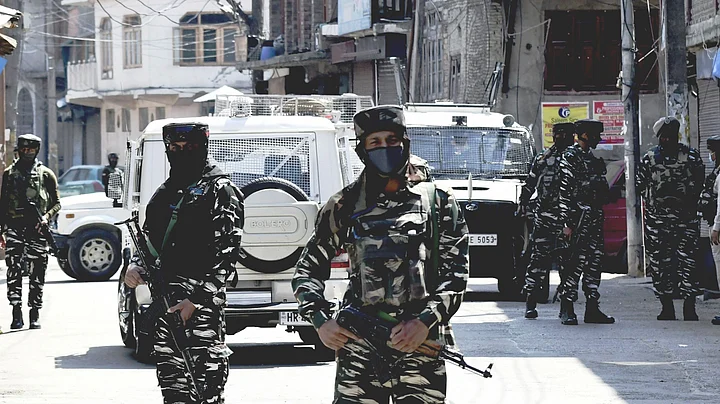Fatima (name changed) is a rural housewife in Kashmir. Invariably in a hijab, she steers clear of the room I am in whenever I visit her home. Last Friday, this normally housebound conservative woman suggested to her husband that they walk with their children to the nearest highway and sit at the roadside in protest. Just the family.
That’s how upset she was over the killing of two school teachers by terrorists in the inner city of Srinagar on Thursday. A lot of Kashmiris have been deeply upset at the spate of killings. Seven persons, including the two teachers, were gunned down.
Those teachers were picked out of a line-up of teachers and shot for being non-Muslim. The principal was a Sikh woman. The other teacher shot was a Pandit, whose family had long been based in Jammu.
The previous day, a prominent Pandit pharmacist had been killed. So had a poor paani-puri seller from Bihar, in a Lal Bazar suburb of the old city.
A Kashmiri Muslim, too, was killed that Wednesday. His father and brother told the media that, when they had found him lying a little distance from a highway, he had told them he was taken there by a bunch of men and shot. They went to Srinagar’s press colony to raise questions about what had happened, and how.
Questions Lurk
Responsibility for the killings was claimed by The Resistance Front — and ISIS for one of the killings. TRF, which has come up in the last couple of years, is said to be fronting for the Pakistan-based Lashkar-e-Toiba. It is not on any international list of banned terror organisations.
Questions abound. The place is abuzz with a sense that something is amiss, that the wheels within wheels that have been the hallmark of the Kashmir story, are spinning silently in the background again.
The fact that ML Bindroo, the prominent pharmacist, was killed at his shop opposite Iqbal Park raised questions in some minds. The spot is a kilometre from Jehangir Chowk, which is to Srinagar what IFFCO chowk is to Gurgaon, and it’s surrounded by major forces’ installations.
A leading light of Srinagar tells me there are sensors in the area that buzz if anyone passes with even a cartridge, leave alone a weapon. That might be an exaggeration, but one, in any case, hopes that the forces have technical and other systems in place to prevent this sort of attack.
Focus on Pandits
The distress and anger caused by the killings is most intense among minorities such as Pandits, Sikhs — plus Shia such as Fatima — and politicians and others associated with the establishment. Some others are pleased with their discomfiture, of course, but the large majority is wary, watchful, uneasy.
A lot of Pandits in the employ of the government have apparently been given leave for ten or 12 days — basically two weekends — and a working week. Some of them moved families out to places like Jammu for a while.
Yet, there is nothing like the panic of early 1990. I vividly recall the terror among Pandits when I visited Habba Kadal, the main Pandit enclave, in February 1990. Many had begun to flee, but others were not sure what they should do.
Their decision was easy once the government announced that salaries would be paid in Jammu. From February to August that year, a steady stream of terrified Pandits rushed to Jammu with almost nothing. The total number was finally in lakhs.
The government, which has made inadequate progress to rehabilitate Pandits during the three-and-a-quarter years since the Centre took direct charge of Jammu and Kashmir, must not repeat the missteps of 1990.
There has been talk in recent weeks of schemes to restore to their earlier Pandit owners properties which were bought by Muslims during the 1990s, often at throwaway prices. Some in Srinagar now speculate about whether the killings are related to that move.
Many of those who took over those properties in the `90s were influential in society and the administration. That makes the process of restoration a minefield.
Don’t Forget the Big Picture
At one level, it feels like Alice in Wonderland. For, amid all the hushed talk of whodunit and what-now, the huge security challenges from both the east and the west appear to have faded.
The government had let go one of the advisors to the governor, a long-time administrator from the erstwhile state’s cadre, just before these killings.
A far more junior IAS officer, who had resigned in a bid for political power almost four years ago, was apparently considered as his replacement, but the government had second thoughts after an adverse social media reaction.
It’s time the government got earnestly down to the business of governing instead of playing around with vacuous projection and virtue signalling.
More importantly, the forces and agencies must get down to their core task of securing the nation against external enemies instead of organising volleyball tournaments, music shows, and interaction programmes for politicians. These are no doubt lucrative, but there are enemies at the gates.
(David Devadas is the author of 'The Story of Kashmir' and 'The Generation of Rage in Kashmir' (OUP, 2018). He can be reached at @david_devadas. This is an opinion piece and the views expressed above are the author’s own. The Quint neither endorses nor is responsible for the same.)
